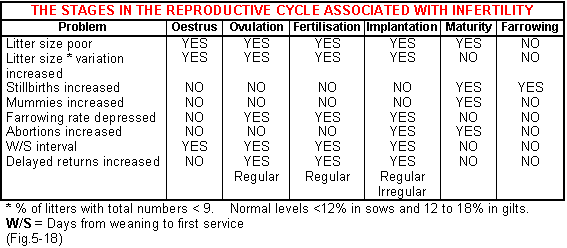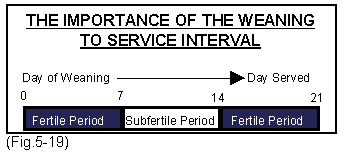



Ovulation and egg production losses
Refer back to Fig.5-14 to note the areas of fertility failure.

Group 2 losses are related to poor egg production or poor ovulation. If there is a failure here the changes will include a low litter size, litter size variation (an increase in litters with total born of less than 9), or a possible decrease in farrowing rate as a result of insufficient embryos to maintain the pregnancy. Use the farm records to identify the group loss by referring to the factors listed in Fig.5-18. These will then indicate which group or groups are involved.

Key factors to maximising ovulation rate:
- Ensure the gilt is fed ad lib for at least two weeks prior to service.
- Keep breeding females that have the best hybrid vigour and that are from the most prolific dam lines. The pure bred female is less fertile than the cross bred. There are considerable variations in fertility between different ancestral lines and types of crossbreeds.
- Breed from females with records of high litter size merit.
- Feed a good quality diet during lactation and in the case of the gilt for three weeks prior to mating.
- Do not serve breeding females which have any signs of disease.
- Check parasite levels. Heavy burdens can impair digestion and the uptake of nutrients and be responsible for poor body condition, catabolism and anoestrus.
- See the checklists for anoestrus in gilts, and anoestrus sows.
- Maximise feed intake in the first lactation.
- Manage the sow so that she comes into oestrus during the early fertile period. (Fig.5-19)








